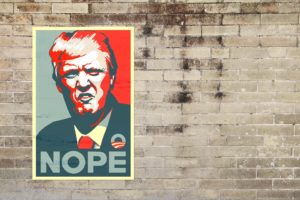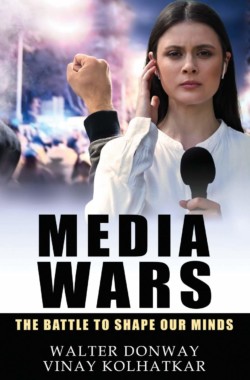Driving Trump from Office: The First Skirmish
The “Not Our President Elite” (NOPE) believes that a frighteningly ignorant, bigoted, and distinctly inferior America—not the America of NOPE—elected Donald Trump. Defeated in the election. NOPE must save America by reversing the election.
What I call the “Not Our President Elite” (NOPE) believes that a frighteningly ignorant, bigoted, and distinctly inferior America—not the America of NOPE—elected Donald Trump. Defeated in the election, not only for President, but for control of Congress and statehouses nationwide, NOPE must save America by reversing the election. There is a precedent for it and NOPE remembers it.
NOPE is an increasingly coordinated movement of news media, left-leaning groups, and legions of ideologues of today’s New (“Postmodernist”) Left that is pursuing two strategies for clawing back political power after the 2016 election. The strategies didn’t emerge from a “conspiracy”; in fact, they are classic means of “destabilizing” governments when an election’s losers refuse to accept the verdict.
 The first is to create a permanent sense of crisis by histrionically portraying every initiative of the Trump administration as warranting nationwide resistance. By framing every action of the new administration as outraging law, American values, and mere decency—and constructing a media drama with “news” stories, features, columns, editorials striking poses of shock—NOPE can radicalize moderate opponents of Trump—those who fail to grasp that the Great Satan sits in the White House. (Yes, the apocalyptic pitch of NOPE is reminiscent of the oratory of Iran’s fanatic leaders. Look at Time’s cover, this week, on Steve Bannon, senior White House advisor).
The first is to create a permanent sense of crisis by histrionically portraying every initiative of the Trump administration as warranting nationwide resistance. By framing every action of the new administration as outraging law, American values, and mere decency—and constructing a media drama with “news” stories, features, columns, editorials striking poses of shock—NOPE can radicalize moderate opponents of Trump—those who fail to grasp that the Great Satan sits in the White House. (Yes, the apocalyptic pitch of NOPE is reminiscent of the oratory of Iran’s fanatic leaders. Look at Time’s cover, this week, on Steve Bannon, senior White House advisor).
The second strategy is to call out, and then transmute into alarming headline reports—and glamorize—street protests at every new “crisis,” “outrage,” and “threat to America.” When thousands routinely take to the streets, called forth by media outlets and “activist” groups, the quality of political discourse plunges. More participants take to the streets because they are assured that another outrage is occurring. All our experience suggests that young people in street demonstrations are aroused to a sense of revolutionary urgency, defiance of an outrage, and, above all, being “in”—belonging to the right side. Incited repeatedly, they become the mobs of the kind that third-world politicians mobilize at will.
Trump’s immigration order
Just a week into the new Trump administration, protestors were called out to protest at airports around the country against the administration’s order to review U.S. immigration security. The day that Trump authorized the review, the New York Daily News ran a one-word headline, filling its front page: “Crisis.” News outlets in the reliable political hotspots—New York City, Washington, Chicago, Los Angeles—rang the tocsins of alarm. By Sunday, the protestors were at a few airports, especially JFK in New York, chanting, shouting, and waving signs, including the common “No Fascist USA.”
NOPE is an increasingly coordinated movement of news media, left-leaning groups, and legions of ideologues of today’s New (“Postmodernist”) Left that is pursuing two strategies for clawing back political power after the 2016 election.
With newspapers and television wallpapered with images of protests and interviews with enraged, tearful, or panicky protesters, thousands more protestors hit more than 30 airports.
My crucial premise here is that the administration’s initiative is decidedly moderate. Throughout his campaign, Trump promised that he would temporarily halt immigration from countries breeding radical Islamic movements until he could be sure that the “vetting” process was identifying and barring terrorists. The seven countries chosen as presenting an active threat were listed in fact by the outgoing Congress and the Obama administration.
He mandated a pause in entry into the United States by refugees from Iran, Iraq, Syria, Libya, Somalia, Sudan, and Yemen. You may recognize that these countries have been in the news continuously in reports on terrorism, including military progress and devastation by ISIS. Refugees from the seven are barred from entering the United States only for 90 days. There is an indefinite ban on admitting more of the millions of refugees from Syria, an ISIS stronghold.
Trump pledged in his campaign to reduce risk while reviewing how people entering the United States from those countries are screened to identify threats. After the review, entry into the United States opens, again, with whatever additional vetting might be added.
Problems? Yes, but not a crisis
One can argue with the program. There are vetting procedures set up by the Obama and previous administrations. The seven nations have majority Muslim populations and thus, although entry is barred without regard for religion, the United States is singling out Islamic nations. In fact, however, most countries with large Muslim populations are not included in the program. Coming from another point of view, the program could be attacked as cynically limited. Saudi Arabia, one of the world’s sources of funds for terrorist organizations, is not included. Nor is Egypt, whose refugees in Europe have been implicated in attacks on women, including gang rapes. Why are these countries excluded? Probably because they are trading partners and political allies of the United States.
Notice that the program is so limited and moderate in its goals—a review of procedures—that media outlets quickly focused on the real-life “victims.” An estimated 100 to 200 people already traveling when the order was signed reached U.S. airports and were detained. They had approved documents for entry, but the Trump executive order put on hold their entry.
To travel far, leaving a country in chaos, and arrive at the United States, weary but excited at the prospect of a new life in freedom—and then to be stopped and told there is a “problem”—must be disheartening. The news media swooped down on a few individuals in very “human” interviews. Lawyers rushed to court and obtained an order that travelers with valid papers could not be sent back. Headlines screamed that a court had blocked Trump. The crisis had reached a thrilling climax. A man from Iraq who had served U.S. troops there as an interpreter wept for the cameras, saying he had his papers and deserved to enter.
By the time the court issued the injunction, about 40 detainees, including the man from Iraq, already had been vetted and admitted to the country. The Trump administration’s first initiative (apart from internal government reorganization), was not a “crisis,” nor a “sweeping ban,” nor an occasion for “Lady Liberty Weeps.”
And yet, NOPE mobilized thousands of protestors. This may have been easier because it was the first call to protest after the new administration actually took office. Given reports of near illiteracy and ignorance of history and geography on many high-school and college students, I wonder if marching and chanting by torchlight may be more appealing than devising and expressing an argument. Earmarks of classic leftist protests were apparent, including widespread use of “Fascist” to name any opponents.
Humiliated, NOPE vowed permanent protest. There were repeated calls never to “normalize” Trump. NOPE’s goal is to make it impossible for Trump to govern—and, if possible, to drive him out of office. And they have in mind an inspiring precedent.
As I reported during the election, the liberal-leftist press wagered everything on winning for their candidates (Sanders, then Clinton) and ideas. They jettisoned objectivity, factuality, and balance—and later flung aside fairness and even decency—in their headlong drive for victory. Despite their defeat, their campaign radicalized (not to mention, frightened) millions of Americans, perhaps especially women.
Humiliated, NOPE vowed permanent protest. There were repeated calls never to “normalize” Trump. NOPE’s goal is to make it impossible for Trump to govern—and, if possible, to drive him out of office. And they have in mind an inspiring precedent.
The Watergate precedent
Ayn Rand observed the same pattern when Richard Nixon, in 1972, defeated the darling of left-liberalism, Sen. George McGovern, and the media began a crusade to regain its dignity. In an Ayn Rand Letter dated April 9, 1973, entitled “Brothers, You Asked for It!” she began with incomparable drama: “I had hoped to write a letter, someday, entitled ‘Why I Will Not Write About Watergate’—and explain that I do not take part in lynching.”
Although Rand had endorsed Nixon in the 1972 election, she did not champion him in Watergate, except to say that this was a lynching, given the actual “crimes” alleged.
Although Rand had endorsed Nixon in the 1972 election, she did not champion him in Watergate, except to say that this was a lynching, given the actual “crimes” alleged, and that Nixon’s philosophical pragmatism had delivered him to his enemies—enemies who also were pragmatists. But she highlighted the true origin of the lynch-mob loathing of the President, writing that “A touch of gloating hatred for the political Right breaks through … in the form of an attempt to involve half-a-nation (or more) in their [liberal-left media] broad ideological smear.” The “half a nation (or more)” were those who defied the press by defeating McGovern and giving Nixon a historical landslide victory. Probably many younger Americans who bought into the rationalizations for a campaign of vindictive character assassination never knew that Nixon’s unforgiveable “crime,” as Paul Johnson traces in his history referenced below, was lifelong anti-communism.
The media hailed themselves as heroes for “saving the nation” by staging Watergate; the public bought the story. People still believe in the “Watergate” legend. But historians have had time to review the record. The dean of British historians, Paul Johnson, in A History of the American People (New York City, 1997), reviewing the events, concludes that “…the anti-Nixon campaign, especially in the Washington Post and the New York Times, was continual, venomous, unscrupulous, inventive, and sometimes unlawful…. [T]he hysteria usually associated with American witch-hunts took over and all reason, balance, and consideration for the national interest was abandoned (pp. 901-3).” That will sound familiar if you were awake during the 2016 election.
The media hailed themselves as heroes for “saving the nation” by staging Watergate; the public bought the story. People still believe in the “Watergate” legend. But historians have had time to review the record.
The media will try to reenact their Watergate victory with President Trump. Trump cannot stop them, but he can deflate their credibility with well-planned initiatives—some commendably radical, like cutting the EPA down to size—implemented in a way that minimizes “collateral damage”—like passengers stuck in airports. He can minimize his off-handed comments that are so easy to seize upon out of context; my own initial impression is that he is doing so.
Pres. Trump must continue his confrontation of the media and his other critics. He must not hope to call a ceasefire with his media enemies. Such a ceasefire will be observed on only one side. But his frank reprimands of the media must be factually correct and impeccably logical. His rebukes must be found to be accurate when his enemies and supporters finish investigating.
Meanwhile, get used to Watergate reruns.
At this time, the Ninth Circuit Court of Appeals, at the request of two states, has halted implementation of the Trump executive order without judging on its merits; the case may reach the U.S. Supreme Court in coming weeks.
This essay was first published on The Atlas Society’s website as “Watergate Reruns: The Campaign to Overturn the Election.”
« To Dare to Speak Its Name: Ayn Rand’s Mastery of Invective Love and Anthropology »










